Some people are perfectly content to lace up their running shoes and jog around their neighborhood or put in a few miles on the local high school track.
You, on the other hand, are not in this group. From the moment your shoes hit a dirt trail, you knew that your running life was transformed for the better. Now you are a devoted trail runner and enjoy working out on local trails instead of chasing pavement.
In order to be the best trail runner you can be — and not risk injury or other issues — you know you must lead a healthy lifestyle that involves eating healthy, training right and wearing the proper gear. And while you have a general idea of what you should and should not do, the following tips will help you to enjoy your favorite form of exercise in the safest way possible:
Table of Contents
1. Stock Up on the Right Foods
The next time you’re making your shopping list, be sure to jot down foods like almonds, eggs and sweet potatoes. Experts say runners should eat a small handful of almonds at least three to five times a week. If you aren’t allergic or averse to them, almonds are a tasty way to boost your Vitamin E intake, along with potentially lowering your cholesterol levels and reducing your chances of heart disease.
Then there are eggs, which are rich in protein and contain virtually all the amino acids your hard-working muscles need to recover after a workout. Eggs are also super versatile and can be part of a healthy breakfast or chopped up and added into salads for lunch or dinner. Meantime, sweet potatoes are super rich in beta-carotene, as well as Vitamin C and several other nutrients, including manganese and copper.
Other tasty and nutritious foods to keep on-hand include whole-grain cereals with added protein, canned black beans, pre-washed salad greens, citrus fruits and lean chicken and fish.
2. Train in a Body-Friendly Way
Whether you’re new to trail running or have been doing it for a while, you have probably noticed how it’s much different than chugging around a track. Now, newbies shouldn’t worry about their speed right off the bat; instead, experts encourage you to find a rhythm that feels comfortable. You may find it takes twice as long to cover a mile, and that’s okay — you need to give your body time to learn to adjust to trail running.
Additionally, when running on a trail, use your arms to help keep your balance. When you’re tackling a hill, pump your arms vertically from your hips up toward your shoulders and keep your elbows wide and farther away from your body when going downhill or over bumpy areas.
Don’t be hard on yourself if you find the terrain to be rugged and need to stop and walk from time to time. Take your time going over any obstacles and remind yourself that you’re still moving and getting great exercise, even if you’re climbing carefully over a downed tree instead of leaping across it like a gazelle.
3. Wear Proper Shoes
When you first started trail running, you might have gotten by with your regular running shoes. But to really protect your feet and avoid injury, it’s best to invest in shoes that are designed for off-road running.
For example, Columbia sells a variety of lightweight shoes that are made expressly for running on rugged trails and whose soles are supportive and protective to help prevent you from falling and your legs from tiring out.
Enjoy Your New Workout While Staying Safe
Trail running is definitely a great way to get outdoors and into better shape. You can run on your own, in trail running groups and clubs, and in competitive races. But in order to get the most out of these experiences, you’ll want to make it a point to eat properly and take care of yourself. By focusing on eating right, taking a slow and steady approach to training and wearing the right gear, you’ll no doubt enjoy trail running for years to come.







